Contact
Automated Processing, Characterization and Manipulation at Nanoscale
Automated Processing, Characterization and Manipulation at Nanoscale
During the last years the field of manipulation, characterization and processing of nanomaterials has become one of the main research topics in material science and nanotechnology. The extraordinary physical properties of novel nanomaterials enable numerous applications. We are working with nanomaterials referring to structures with nanometer sizes in at least one dimension: monolayered sheets of carbon, so-called graphene, is the best-known example for two-dimensional nanostructures, while nanotubes and nanowires made of different materials, such as Au, Si, and ZnO, are fascinating one-dimensional structures in which carbon nanotubes (CNTs) are the most prominent example. These nanomaterials provide a basis for novel actuator and sensor technologies and can improve existing electronic devices, aiming primarily at nano-electro-mechanical systems (NEMS).
To optimize the nanomaterials’ fabrication techniques and allow the assembly of prototypic devices, reliable manipulation, characterization and flexible processing of these nanomaterials is required. In this area, the micro-nano-integration of these nanomaterials into existing microsystems remains a challenge. Automated nanorobotic systems are one of the most promising enabling technologies for this challenge closing the gap between bottom-up and top-down approaches. We develop nanorobotic strategies for the manipulation, characterization and processing of nanomaterials bringing them one step closer to their potential applications.

Graphene
Graphene is a two-dimensional monolayer of carbon atoms arranged in a honeycomb crystal. It is a material with remarkable and unique properties: Graphene is the thinnest and strongest material known and shows the highest thermal and electrical conductivity ever measured at room temperature. It reconciles such conflicting qualities as brittleness and ductility and promises a variety of potential applications, e.g. field emission, sensors, flexible electronics and energy.
Handling and manipulation of suspended graphene requires adapted experimental setups due to the extraordinary high adhesive forces of this true 2D nanomaterial. Our research activities focus on the analysis of suspended graphene flakes applying different nanorobotic strategies and tools such as high-aspect ratio tungsten tips, AFM cantilever or micro-four-point probes. These tools are driven by robotic stages with internal sensors having nanometer accuracy in closed-loop mode. The stages are mounted inside the vacuum chamber of a high-resolution scanning electron microscope equipped with a focused ion beam and gas injection system offering diverse manipulation, characterization and processing opportunities with direct visual feedback. In this way, the nanorobotic tools can be applied for local electrical and mechanical characterization experiments as well as for handling procedures suitable for prototyping of graphene-based devices.
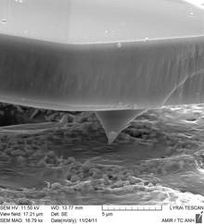
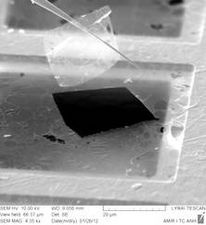
Nanowires
One-dimensional objects, so-called nanowires and nanotubes, are highly discussed and gained more and more importance over the last decade. Their tiny dimensions itself reveal already quasi quantum-mechanical behavior, which results in tremendously improved material properties. Some nanowires for example, possess extraordinary performance in electrical conductivity, mechanical strain or semiconducting properties facilitating an improvement of conventional electromechanical devices: Applying these super-small objects as responsive part of a sensor can increase detection sensitivity and detection time, while decreasing power consumption and weight.
Our research involves nanowires made of different materials: from ordinary metal nanowires such as copper, covering semiconducting materials like silicon, silicon carbide and zinc oxide, up to novel materials such as carbon nanotubes. The research includes the mechanical and electrical characterization of these components, as well as their application in novel and prototypic devices as sensors and prototypic nano-electro-mechanical systems (NEMS).
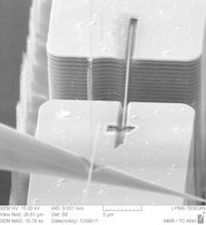
Carbon nanotubes
The extraordinary physical properties of CNTs are the reason for a multitude of potential applications that are foreseen in different areas. Micro-nano-integration of CNTs into existing micro systems is one of the main challenges. In order to optimize the fabrication techniques and to allow the assembly of CNT-based prototypic devices, reliable handling and characterization of CNTs is required. We are developing nanorobotic methods for the handling, characterization and processing of individual CNTs. For this purpose, a nanorobotic system is integrated into a scanning electron microscope (SEM) facilitating the development of direct and nondestructive methods for mechanical and electrical characterization of as-grown CNTs that are coming directly from its CVD-based fabrication without any further treatment. In addition, strategies for the reproducible microgripper-based pick-and-place handling of CNTs are developed that enable the assembly of prototypic CNT-based devices. Focused ion beam (FIB) processing is used to shorten and bend carbon nanotubes.
AFM-based nanomanipulation and 3D-nanometrology
The atomic force microscope (AFM) is used to perform characterization of nanomaterials by force-distance-curves or even AFM-based nanomanipulation or structuring. We worked on the development of drift compensation techniques in order to realize a full automation of AFM-based nanomanipulation and lithography tasks. Furthermore, we are developed exchangeable and customizable AFM probe tips as well as nvel scanning algorithms that allow for a three-dimensional analysis of high aspect ratio structures and sidewall scanning.
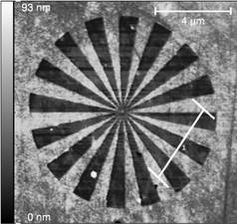
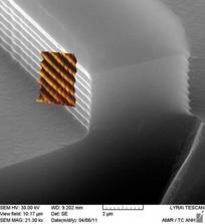
Processing of Nanomaterials
Another field of research is the machining of materials on the micro- and nanoscale, whereby particle beam based deposition and etching technologies, such as EBiD and FIB milling, are used. As an example, this allows retrospective structuring of semiconductor surfaces and the construction of nanoscale sensors, actuators and other functionalized elements. According to this, we develop and apply gas injection systems, which allocate the necessary process gases.
The process of Electron Beam induced Deposition (EBiD) allows to create structures with dimensions of only some hundred nanometers by writing them with an electron beam, e.g. in a scanning electron microscope (SEM). In our division EBiD is used and improved for different applications. A standard application is nanobonding, where the deposition acts as a kind of glue to connect micro- or nanoscale Objects to each other. Another application is the creation of electrical connections. Therefor nanoscale electrical conductive lines are "written" onto suitable surfaces, e.g. to connect small objects which are situated on the surface. The most challenging application for EBiD is the creation of three dimensional structures with special properties. Examples are solid or flexible elements for nanorobotic applications, functionalized parts with special electrical or electromechanical properties or sensor elements.
Focused ion beam (FIB) milling enables the direct processing of Nanomaterials by a sputtering process. This can not only be used for a precise structuring of the nanomaterials itself, but also facilitates the processing and manufacturing of suitable testing substrates and prototypic device architectures.


Electrical contact measurements at submicrometer scale
In this area, various techniques are investigated for more accurate and reliable contact measurements in the submicrometer range. The use of automatable, robotic fine positioning systems is indispensable. These are used in conjunction with high-resolution microscopy to investigate and further develop various techniques:
- Development of a contact probing setup
- To support RF and DC measurement techniques
- for applications in high vacuum (SEM chamber)
- highly accurate positioning of at least 2 probes in 6 DOF to the substrate
- Investigation of techniques to optimize the probing process, e.g.
- Automation of the probing process
- Keep electrical contact resistance constant and minimize wear
- Self-sensing probes
- Investigation of error sources during the probing process and techniques for minimizing them (systematic errors, errors due to misalignment, ...)
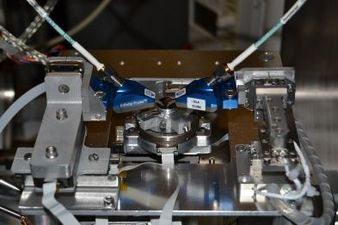
Projects
Current Active Projects
Completed Projects
- ScanPro2D - Scanning Probe Processing of 2D Materials
- Nano-Q - Nanogranulare Sensoren für personenbezogenes Quecksilber-Monitoring
- RACoNa - Reliable Assembling of Colloidal Nanoparticles in Two and Three Dimensions by Dual-AFM-based Handling inside a Scanning Electron Microscope
- DriftAFM - Kompensation von thermalen Drifteffekten in der Rasterkraftmikroskopie
- Powerbonds - Enhancement of Fiber and Bond Strength Properties for Creating Added Value in Paper Products
- NADESTA - Development of a Nanohandling Desktop Station for Nanocharacterization of CNTs and biological cells by a piezoresistive AFM Probe
- EfuSNa - Eigenschaften funktionaler Strukturen auf der Nanoskala, hergestellt durch elektronen-strahlgestützte Verfahren
- NANOBITS - Exchangeable and Customizable Scanning Probe Tips
- NANORAC – Nanorobotics for Assembly and Characterization
- NANOHAND - Micro-Nano System for Automatic Handling of Nanoobjects
- FIBLYS - Building an Analyzing Focused Ion Beam for Nanotechnology
- Gold-EBiD - Robotergestützte Herstellung und Charakterisierung von Goldschichten und Goldnanostrukturen aus neuartigen Designerprecursoren
- ZuNaMi - Zukünftige Verfahren der Nano-/Mikroproduktion
- NanoStore - Mikroroboterzelle zur automatisierten Handhabung und Montage von CNTs für die Integration von Mikro- und Nanoobjekten innerhalb eines Rasterelektronenmikroskop
- ROBOSEM - Development of a Smart Nanorobot for Sensor-based Handling

